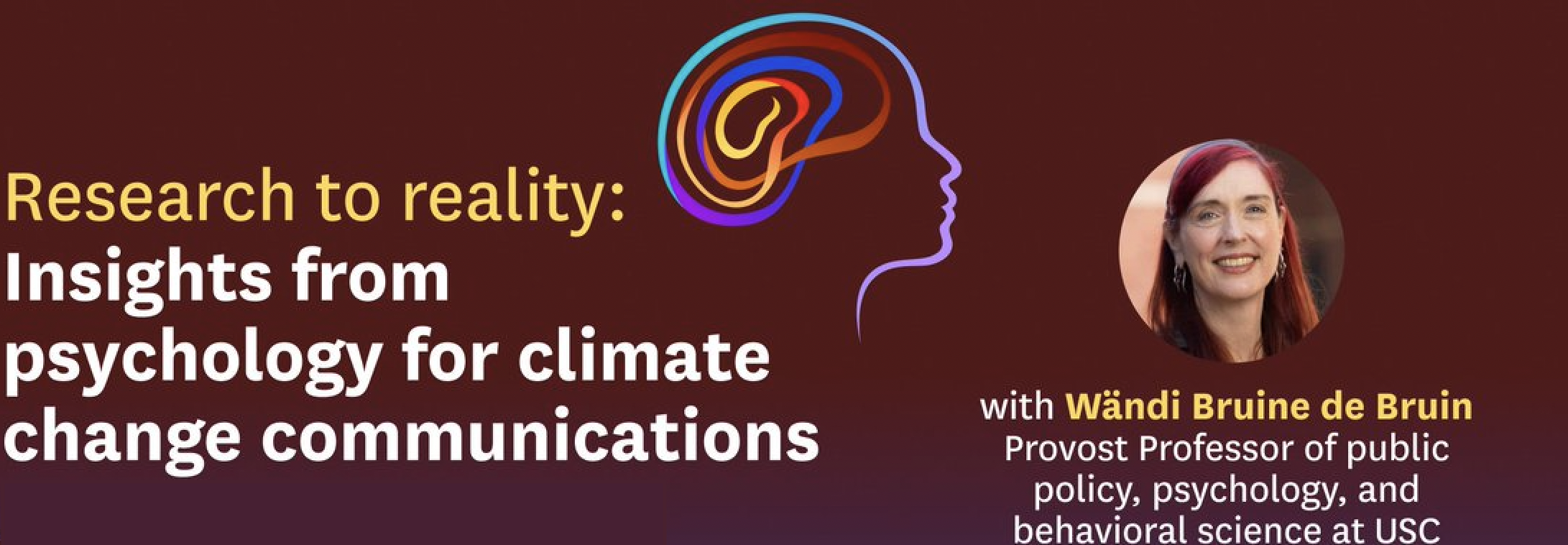Communicating about climate change fosters understanding and inspires action when grounded in both research and simplicity. As emphasized in our most recent ‘Research to Reality’ series, Dr. Wändi Bruin de Bruin, a world-renowned psychologist, policy expert, and professor of practice at the University of Southern California, demonstrates how effective climate storytelling transcends mere data presentation, tapping into the values, beliefs and emotional landscapes of diverse audiences.
According to Dr. Bruin de Bruin, understanding the audience forms the bedrock of effective communication. Psychology shows us that people process information through the lens of their existing beliefs and knowledge. For climate change communication to resonate, it must align with these underlying perceptions. Wändi’s research advocates for a bespoke approach to messaging, one that aligns with the audience’s specific worldview on climate issues. This strategy ensures that the message not only reaches the audience but also engages them meaningfully.
Language wields tremendous power in climate communication. Dr. Bruin de Bruin cautions against complex jargon and abstraction that often alienate rather than enlighten. Simple, concrete language, on the other hand, renders the abstract concept of climate change tangible and comprehensible. This approach breaks down the complexity of climate science, making it accessible to all.
Dr. Bruin de Bruin’s studies highlight the effectiveness of linking climate change to everyday experiences, significantly enhancing engagement. When people see how climate change directly impacts their community, their health, and their future, the issue becomes personal and urgent. This connection motivates individuals to learn more and take action, bridging the gap between global phenomena and personal relevance.
Focusing on solutions and positive outcomes shifts the narrative from despair to hope. Emphasizing actionable solutions and the benefits of addressing climate change not only educates but also empowers the audience. This positive framing counters defeatism, encouraging people to believe that their actions can make a difference.
Social influence, as Dr. Bruin de Bruin’s research confirms, drives behavior change. Showcasing proactive individuals and communities creates a ripple effect, inspiring widespread climate-positive actions.
Encouraging incremental changes demystifies the process of combating climate change. By presenting manageable actions as powerful tools, communication can counteract feelings of helplessness. Small steps, when aggregated, can lead to substantial impacts, reinforcing the message that everyone has a role to play in addressing climate change.
Overcoming psychological biases and misconceptions is another crucial aspect of climate change communication. For instance, the tendency to downplay long-term risks leads to inaction. Effective communication counters this by making the future consequences of climate change feel immediate and personal. This approach compels the audience to view climate change not as a distant threat but as a present reality requiring immediate attention.
Effective climate change communication should ultimately inspire and motivate. By framing messages around empowerment and the tangible benefits of taking action, communicators can drive behavioral change that persists. This approach shifts the focus from fear-based messaging to one that champions the positive impacts of collective and individual actions.
By understanding and leveraging the psychological underpinnings of how people receive and act on information, communicators can turn the tide in the fight against climate change. The goal is to move beyond merely sharing information to sparking a movement where informed, proactive steps towards a sustainable future become the norm.
Michael Kittilson works as a Research Assistant at the Center for Climate Journalism and Communication.
